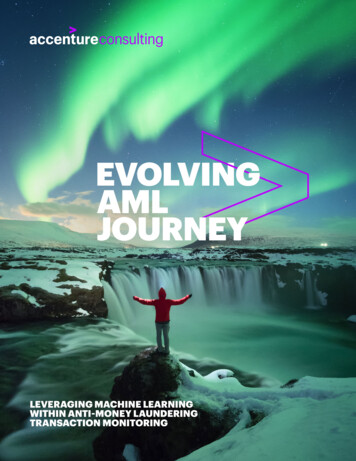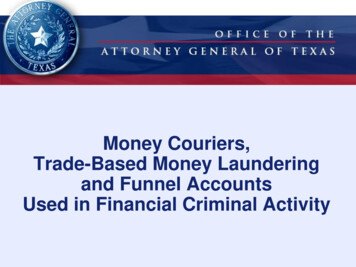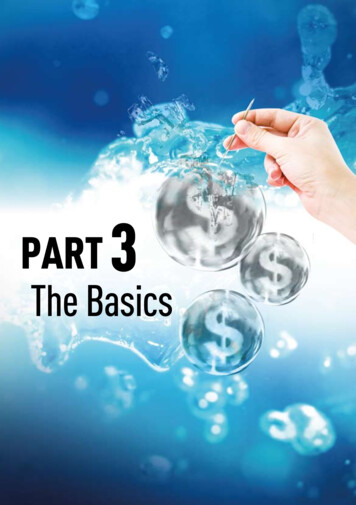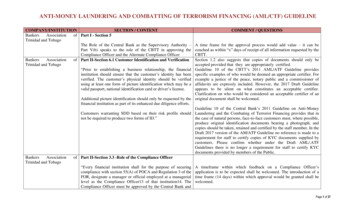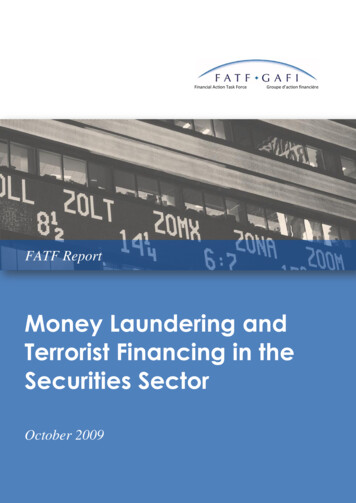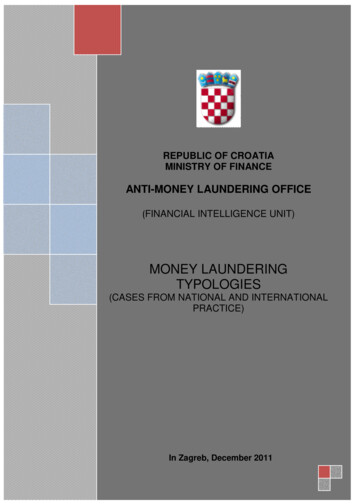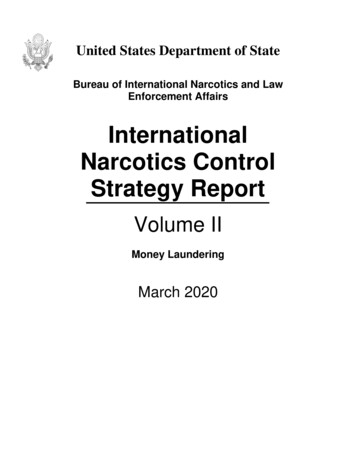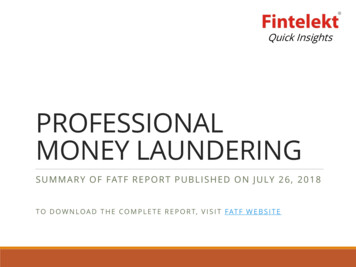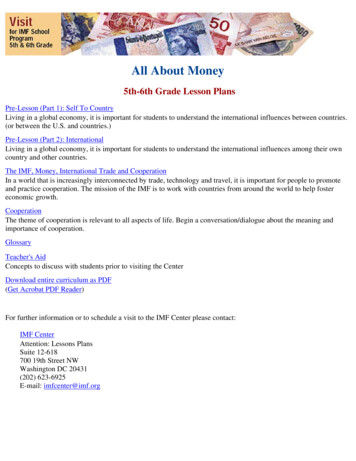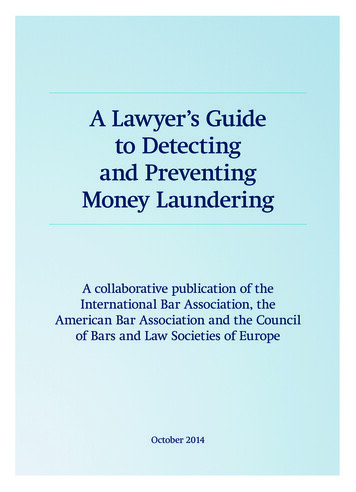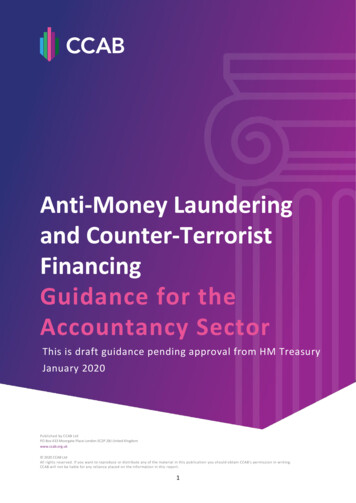
Transcription
Anti-Money Laundering and Counter-Terrorist FinancingGuidance for the Accountancy SectorAnti-Money Launderingand Counter-TerroristFinancingGuidance for theAccountancy SectorThis is draft guidance pending approval from HM TreasuryJanuary 2020Published by CCAB LtdPO Box 433 Moorgate Place London EC2P 2BJ United Kingdomwww.ccab.org.uk 2020 CCAB LtdAll rights reserved. If you want to reproduce or distribute any of the material in this publication you should obtain CCAB’s permission in writing.CCAB will not be liable for any reliance placed on the information in this report.1
Anti-Money Laundering and Counter-Terrorist FinancingGuidance for the Accountancy SectorINTRODUCTIONAccountants are key gatekeepers for the financial system, facilitating vital transactions that underpin the UKeconomy. As such, we have a significant role to play in ensuring our services are not used to further a criminalpurpose. As professionals, accountants must act with integrity and uphold the law, and must not engage in criminalactivity.This guidance is based on the law and regulations as of 10 January 2020. Please note that some of therequirements of the regulations relating to EU lists are expected to fall away at the end of the transitional period.This guidance covers the prevention of money laundering and the countering of terrorist financing. It is intendedto be read by anyone who provides audit, accountancy, tax advisory, insolvency, or trust and company services inthe United Kingdom and has been approved and adopted by the UK accountancy AML supervisory bodies.The guidance has been prepared jointly by the CCAB bodies:Institute of Chartered Accountants in England and WalesAssociation of Chartered Certified AccountantsInstitute of Chartered Accountants of ScotlandChartered Accountants IrelandThe Chartered Institute of Public Finance and AccountancyIt has been approved and adopted by the UK accountancy supervisory bodies:Institute of Chartered Accountants in England and Wales – www.icaew.com/Association of Accounting Technicians – www.aat.org.uk/Association of Taxation Technicians – www.att.org.uk/Association of International Accountants – www.aiaworldwide.com/Institute of Certified Bookkeepers – www.bookkeepers.org.uk/Chartered Institute of Management Accountants – www.cimaglobal.com/1
Anti-Money Laundering and Counter-Terrorist FinancingGuidance for the Accountancy SectorInstitute of Financial Accountants – www.ifa.org.uk/International Association of Bookkeepers – www.iab.org.uk/Association of Chartered Certified Accountants – www.accaglobal.com/uk/en.htmlChartered Institute of Taxation – www.tax.org.uk/Insolvency Practitioners Association – www.insolvency-practitioners.org.uk/Insolvency Service – viceHM Revenue & Customs – tomsInstitute of Chartered Accountants of Scotland – www.icas.comChartered Accountants Ireland - https://www.charteredaccountants.ie/Note: A Tax Appendix exists as supplementary guidance and should be consulted by tax practitioners’ -for-TaxPractitioners-.pdfNote: An Insolvency Appendix exists in draft form, pending HMT approval, so should be consulted by insolvencypractitioners as supplementary guidance. -forInsolvency-Practitioners-.pdf2
Anti-Money Laundering and Counter-Terrorist FinancingGuidance for the Accountancy SectorCONTENTS123456ABOUT THIS GUIDANCE1.1What is the purpose of this guidance?1.2What is the scope of this guidance?1.3What is the legal status of this guidance?MONEY LAUNDERING AND TERRORIST FINANCING2.1What are the fundamentals?2.2What are criminal property and terrorist property?2.3What are the Primary Offences?2.4What is the Failure to Report offence?2.5What is the Tipping Off offence?2.6What is the Prejudicing an Investigation offence?RESPONSIBILITY & OVERSIGHT3.1What are the responsibilities of a business?3.2What does Regulation 26 require of beneficial owners, officers and managers (BOOMs)?3.3What are the differences in requirements for sole practitioners?3.4What are the responsibilities of Senior Management/MLRO?3.5How might the MLRO role be split?3.6What policies, procedures and controls are required?RISK BASED APPROACH4.1What is the role of the risk-based approach?4.2What is the role of senior management?4.3How should the risk assessment be designed?4.4What is the risk profile of the business?4.5How should procedures take account of the risk-based approach?4.6What are the different types of risk?4.7Why is documentation important?CUSTOMER DUE DILIGENCE (CDD)5.1What is the purpose of CDD?5.2When should CDD be carried out?5.3How should CDD be applied?5.4Can reliance be placed on other parties?5.5What happens if CDD cannot be completed?5.6What are the obligations to report discrepancies in the People with Significant Controlregister?SUSPICIOUS ACTIVITY REPORTING6.1What must be reported?6.2What is the Failure to Report Offence?6.3What is the Tipping Off Offence?6.4What is the Prejudicing an Investigation Offence?6.5When and how should an external SAR be made to the 33536364345515456595962636565
Anti-Money Laundering and Counter-Terrorist FinancingGuidance for the Accountancy Sector7896.6What is a DAML and why is it important?6.7What should happen after an external SAR has been made?RECORD KEEPING7.1Why may existing document retention policies need to be changed?7.2What should be considered regarding retention policies?7.3What considerations apply to SARs and DAML requests?7.4What considerations apply to training records?7.5Where should reporting records be located?7.6What do businesses need to do regarding third-party arrangements?7.7What are the requirements regarding the deletion of personal data?TRAINING AND AWARENESS8.1Who should be trained and who is responsible for it?8.2Who is an agent?8.3What should be included in the training?8.4When should training be completed?GLOSSARY & APPENDICES9.1Glossary9.2APPENDIX A: Subcontracting and Secondments9.3APPENDIX B: Client Verification9.4APPENDIX C: When to make a SAR9.5APPENDIX D: risk factors – per regulations 33(6) & 37(3)9.6APPENDIX E: client due diligence case 0103
Anti-Money Laundering and Counter-Terrorist FinancingGuidance for the Accountancy Sector11.1ABOUT THIS GUIDANCE What is the purpose of this guidance? Who is the guidance for? What is the legal status of this guidance?What is the purpose of this guidance?1.1.1This guidance has been prepared to help accountants (including tax advisers and insolvencypractitioners) comply with their obligations under UK legislation to prevent, recognise and reportmoney laundering. Compliance with it will ensure compliance with the relevant legislation(including that related to counter-terrorist financing) and professional requirements.1.1.2The term ‘must’ is used throughout to indicate a mandatory legal or regulatory requirement. IfBusinesses require assistance in interpretation of the UK anti-money laundering and terroristfinancing (AML) regime, they should seek advice from their anti-money laundering supervisoryauthority or consider seeking legal advice. In all cases businesses should document and be able tojustify their decision.1.1.3Where the law or regulations require no specific course of action, ‘should’ is used to indicate goodpractice sufficient to satisfy statutory and regulatory requirements. Businesses should considertheir own particular circumstances when determining whether any such ‘good practice’suggestions are indeed appropriate to them. Alternative practices can be used, but businessesmust be able to explain their reasons to their anti-money laundering supervisory authority,including why they consider them compliant with law and regulation.1.1.4The UK anti-money laundering regime applies only to defined services carried out by designatedbusinesses. This guidance assumes that many businesses will find it easier to apply certain AMLprocesses and procedures to all of their services, but this is a decision for the business itself. It canbe unnecessarily costly to apply anti-money laundering provisions to services that do not fall withinthe UK AML regime.1.1.5This guidance refers, in turn, to guidance issued by bodies other than CCAB. When those bodiesrevise or replace their guidance, the references in this document should be assumed to refer to thelatest versions.1.1.6Businesses may use AML guidance issued by other trade and professional bodies, including theJoint Money Laundering Steering Group (JMLSG), where that guidance is better aligned with the5
Anti-Money Laundering and Counter-Terrorist FinancingGuidance for the Accountancy Sectorspecific circumstances faced by the business. Where the business relies on alternative guidance, itmust be in a position to justify this reliance to their anti-money laundering supervisory authority.Businesses supervised by HMRC should also take into account its published content on GOV.UK.1.1.7The law which comprises the UK AML regime is contained in the following legislation and relevantamending statutory instruments valid as at the date of this guidance: The Proceeds of Crime Act 2002 (POCA) as amended. Particular attention is drawn to theSerious Organised Crime and Police Act 2005 (SOCPA); The Terrorism Act 2000 (TA 2000) as amended. Particular attention is drawn to the AntiTerrorism Crime and Security Act 2001 (ATCSA) and the Terrorism Act 2006 (TA 2006)); The Money Laundering, Terrorist Financing and Transfer of Funds (Information on thePayer) Regulations 2017 (the 2017 Regulations) as amended. Particular attention is drawnto The Money Laundering and Terrorist Financing (Amendment) Regulations 2019));Terrorist Asset-Freezing Act 2010; Anti-terrorism, Crime and Security Act 2001; Counter-terrorism Act 2008, Schedule 7; The Criminal Finances Act 2017.Businesses should ensure that they take account of all subsequent relevant amendments.1.1.8POCA and TA 2000 contain the offences that can be committed by individuals or organisations. The2017 Regulations set out in detail the systems and controls that businesses must possess, as well asthe related offences that can be committed by businesses and individuals within them by failing tocomply with relevant requirements.1.2What is the scope of this guidance?1.2.1This guidance is addressed to businesses covered by Regulations 8(2)(c) and 8(2)(e) of the 2017Regulations. This means anyone who, in the course of business in the UK, acts as: An auditor (Regulation 11(a)); An external accountant (Regulation 11(c)); An insolvency practitioner (Regulation 11(b)); A tax adviser (Regulation 11(d)). A trust or company service provider (Regulation 12(2)).6
Anti-Money Laundering and Counter-Terrorist FinancingGuidance for the Accountancy SectorFor the purposes of this guidance the services listed above are collectively referred to as definedservices. The scope of what would be considered carrying on business in the UK is broad and wouldinclude certain cross border business models where day to day management takes place from UKregistered office or UK head office.1.2.2Regulation 11(c) of the 2017 Regulations defines an external accountant as someone who providesaccountancy services to other persons by way of business. There is no definition given for the termaccountancy services, however for the purposes of this guidance it includes any service whichinvolves the recording, review, analysis, calculation or reporting of financial information, and whichis provided under arrangements other than a contract of employment. If in doubt, Businessesshould confirm with their antimoney laundering supervisory authority whether their activities require supervision under the2017 Regulations.1.2.3Regulation 11(d) of the 2017 Regulations defines tax adviser to include both direct and indirectprovision of material aid, assistance or advice on someone’s tax affairs. This includes any specifictax advice given to clients, including completing and submitting tax returns, advice on whethersomething is liable to tax, or advice on the amount of tax due.1.2.4Where a business is providing tax services through virtual or automated services the business isproviding defined services. Businesses offering software or hardware solutions for accountancy,bookkeeping, payroll or tax are not providing a defined service provided they do not prepare oranalyse any financial information themselves for their clients.1.2.5When considering a service or product involving software or hardware, a business should considerthe quantity and nature of the human input that it may be required to supply as part of the service.For example, a business develops software that identifies a contractor’s IR35 status and calculatestax due. Situation 1: Business A licences the software to new and existing clients without anysupport services. Although the output of the software is tax related, business A is notproviding a defined service. Situation 2: Business A licences the software to new and existing clients. The client has aright to call on Business A for advice on interpreting the output from the software.Business A is providing a defined service. Situation 3: In Situation 1, the client asks Business A for advice on the output under aseparate engagement. This additional service provided by Business A is a defined service.7
Anti-Money Laundering and Counter-Terrorist FinancingGuidance for the Accountancy SectorSimilar considerations arise as in Situations 1, 2 and 3 where payroll services are provided.1.2.6A business may determine that not all the services it offers meets the definition of a defined serviceunder the 2017 Regulations. In such cases, a business may decide that CDD measures do not needto be applied to clients seeking services that are not defined services. However, if a businessdecides not to apply CDD measures, it should document the rationale for its decision.Notwithstanding the fact that certain services may not meet the definition of a defined service, abusiness may choose to still apply CDD measures in such cases.1.2.7This guidance does not cover services other than those in 1.2.1, guidance for which may beavailable from other sources. Businesses supervised by HMRC that provide both accountancyservices and trust or company services should generally follow this guidance but should also haveregard to the HMRC guidance ‘Anti-money laundering guidance for trust or company servicesproviders. Businesses solely providing trust or company services and supervised by HMRC shouldfollow the HMRC guidance.1.2.8Guidance related to secondees and subcontractors can be found in APPENDIX A.8
Anti-Money Laundering and Counter-Terrorist FinancingGuidance for the Accountancy Sector1.3What is the legal status of this guidance?1.3.1This guidance has been approved by HM Treasury, and the UK courts must take account of itscontents when deciding whether a business subject to it has contravened a relevant requirementunder the 2017 Regulations, or committed an offence under Section 330-331 of POCA.1.3.2If an AML supervisory authority is called upon to judge whether a business has complied with itsgeneral ethical or regulatory requirements, it will take into account whether or not the businesshas applied the provisions of this guidance.1.3.3This guidance is not intended to be exhaustive. It cannot foresee every situation in which abusiness may find itself. If in doubt, seek appropriate advice or consult your AML supervisoryauthority.9
Anti-Money Laundering and Counter-Terrorist FinancingGuidance for the Accountancy Sector22.1MONEY LAUNDERING AND TERRORIST FINANCING What are the fundamentals? What are criminal property and terrorist property? What are the Primary Offences? What is the Failure to Report offence? What is the Tipping Off offence? What is the Prejudicing an Investigation offence?What are the fundamentals?2.1.12.1.2Businesses need to assess and be alert to the risks posed by: Clients; Suppliers; Employees; and The customers, suppliers, employees and associates of clients.Businesses must be aware of their reporting obligations. Neither the business nor its client needs tohave been party to money laundering or terrorist financing for a reporting obligation to arise (seeChapter six of this guidance).2.1.3The UK’s MLTF regime covers two distinct areas: Money Laundering and Terrorist Finance. Eachdefines the meaning of “property” for the purposes of the regime (Criminal Property and TerroristProperty) and sets out prohibited conduct involving the property.2.1.4This chapter talks about Anti-Money Laundering and Counter-Terrorist Finance separately. In therest of the guidance “money laundering” should be taken to include terrorist finance unless thewording specifically excludes it.2.1.5Crime is an action or inaction prohibited by law and punishable by the state. It is not civilwrongdoing for which restitution is owed to another person. Where a representative of the state(such as HMRC) can decide whether to treat conduct as a criminal or a civil matter, for the MLTFregime businesses should consider the conduct as criminal, even where the state’s decision is,frequently or even invariably, to treat it as civil.2.1.6The Proceeds of Crime Act relates to property which arises from any criminal activity whethercarried out by the person in possession of the property or a third party.10
Anti-Money Laundering and Counter-Terrorist FinancingGuidance for the Accountancy Sector2.1.7The following diagram explains when conduct (inside or outside the UK) is terrorism, for the MLTFregime:2.1.8As set out above, the key elements of terrorism are a use or threat of action (which could include acyber-attack) designed to influence a state (or international body) or to intimidate or terrorise thepublic for the purpose of advancing a cause11
Anti-Money Laundering and Counter-Terrorist FinancingGuidance for the Accountancy Sector2.2What are criminal property and terrorist property?2.2.12.2.2The property may take any form, including: Money or money’s worth; Securities; A reduction in a liability; or Tangible or intangible assets.There is no need for the property to be in the UK or pass through the UK. There are no materialityor de minimis exceptions.2.2.32.2.4Criminal property is any property that results from: Conduct in the UK that is criminal in the UK; Conduct overseas that would have been criminal had it taken place in any part of the UK. The UK takes an “all crimes” approach – including tax evasion and administrative offences.Terrorist property is any property that is: likely to be used for terrorism, the proceeds of acts of terrorism, or the proceeds of acts carried out for terrorism.2.2.5Note that all the resources of organisations proscribed by TA 2000 are terrorist property.2.2.6It should be noted that, because terrorism and funding terrorism are illegal, terrorist property willalso be criminal property. The fact that the property involved may be both criminal property andterrorist property does not create a dual reporting obligation. For example, the following arecriminal acts that will normally also be terrorist offences if they relate to persons or organisationsengaged in terrorism: Failure to comply with a prohibition imposed by a freezing order or enable any otherperson to contravene the freezing order; and Dealing with, or making available funds or economic resources which are owned,controlled by or benefitting a designated person (under the Office of Financial SanctionsImplementation List).12
Anti-Money Laundering and Counter-Terrorist FinancingGuidance for the Accountancy Sector2.3What are the Primary Offences?2.3.1The Primary Offences may be committed by any person, both those within the regulated sector andthose outside.2.3.2The conduct that can amount to a Primary Offence may include: Taking an action (for example stealing a car); Refraining from taking an action (for example not conducting a mandatory environmentalimpact assessment);2.3.3 A single act (for example, possessing the proceeds of one’s own crime); Complex and sophisticated schemes involving multiple parties; or Multiple methods of handling and transferring property.An individual or entity commits a Money Laundering offence if they; Conceal, disguise, convert or transfer criminal property (POCA 327), Acquire, use or possess criminal property (POCA 329); Are involved in an arrangement that allows another to acquire, retain, use or controlcriminal property (POCA 328); Remove criminal property from a UK jurisdiction (POCA 327). Note that the UK comprisesthree Jurisdictions: England and Wales, Scotland and Northern Ireland. It is an offence tomove criminal property from one of these to another.2.3.4An individual or entity commits a Terrorist Financing offence if they; Raise, receive or provide terrorist property (TA 15); Use or possess terrorist property (TA 16); Are involved in an arrangement that:omakes terrorist property available (TA 17);oconceals terrorist property or transfers it to nominees (TA 18); ororemoves terrorist property from a UK jurisdiction (TA 18). Note that the UKcomprises three Jurisdictions: England and Wales, Scotland and Northern Ireland.It is an offence to move criminal property from one of these to another. Pay an insurance claim to reimburse property that has become terrorist property (TA 17A);13
Anti-Money Laundering and Counter-Terrorist FinancingGuidance for the Accountancy Sector2.3.5A defence is available to charges of money laundering if the persons involved did not know orsuspect that they were dealing with criminal property and in the case of terrorist property if theydid not intend or have reasonable grounds to suspect the property was to be or may be used forthe purposes of terrorism.2.3.6It is possible to obtain a defence (POCA 338 and TA 21ZA) to charges of money laundering andterrorist finance. This defence is available where a disclosure is made of the conduct which wouldotherwise fall within POCA or TA and consent (either a DAML or DATF) is obtained to continue. Inboth Acts, the consent must be obtained before engaging in the conduct concerned (See 6.3).2.3.7The conditions for this defence differ between POCA and TA. In the case of TA the DATF must comefrom the National Crime Agency (NCA). In the case of POCA, if the person seeking a DAML is notthe MLRO, the DAML can be provided by the MLRO (who should have first obtained a DAMLdirectly from the NCA under the provisions of Section 338 of POCA.2.3.8It is not a money laundering offence (POCA 327, 328 and 329) if the conduct that gave rise to thecriminal property: Is reasonably believed to have happened in a location outside the UK where it was legal,and It would have carried a maximum sentence of less than 12 months had it occurred in theUK. The requirements of this overseas conduct exception are complex, onerous andstringent; specialist legal advice may be needed.Note that this exception does not apply to terrorist financing.For further detail please see 6.1.10.2.3.9The maximum penalties for committing a Primary Offence are 14 years imprisonment or anunlimited fine or both (POCA 334 and TA 22).2.4What is the Failure to Report offence?2.4.1The Failure to Report offence (POCA 330 and TA 21A) applies only within the regulated sector. Itoccurs when a regulated person fails to report knowledge or suspicion of money laundering orterrorist finance.2.4.2Remember: There is no de minimis threshold value; and14
Anti-Money Laundering and Counter-Terrorist FinancingGuidance for the Accountancy Sector The anti-money laundering regime includes an overseas reporting exemption (see 6.1.10)but the counter-terrorism finance regime does not.2.4.3There are defences available for charges of failing to report both money laundering and terroristfinance if there is a reasonable excuse for not reporting promptly. Reasonable excuse may includethe following: All the information that the person could provide to the NCA is already known to LawEnforcement because it is in the public domain or because it has already been reported byanother person; or There is another reasonable excuse (this is likely to be defined fairly narrowly, in terms ofpersonal safety or security).2.4.4For further information on this offence and the defences see Chapter Six of this guidance.2.4.5The maximum penalties for committing the Failure to Report offence are 5 years imprisonment oran unlimited fine or both (POCA 334 and TA 21A).2.5What is the Tipping Off offence?2.5.1The Tipping Off offence (POCA 333A and S331 and TA 21D) applies only within the regulatedsector. This offence is committed when: a person in the regulated sector discloses that a SAR or DAML has been made; an investigation into allegations of MLTF is underway (or being contemplated); and the disclosure is likely to prejudice that investigation.2.5.2For further information, including defences to this offence see Chapter Six of this guidance.2.5.3The maximum penalties for committing the Failure to Report offence are 2 years imprisonment oran unlimited fine or both (POCA 333A and TA 21D).2.6What is the Prejudicing an Investigation offence?2.6.1The Prejudicing an Investigation offence (POCA 342 and TA 39) applies to both those within theregulated sector and those outside. Interference with material relevant to an investigation(including falsification, concealment or destruction of documents) can amount to an offence ofprejudicing an investigation. For those outside the regime, revealing the existence of a lawenforcement investigation can amount to an offence (for those within the regulated sector suchconduct is likely to result in a tipping off offence, see 2.5 above)15
Anti-Money Laundering and Counter-Terrorist FinancingGuidance for the Accountancy Sector2.6.22.6.3There is a defence if: There was no suspicion that an investigation would be prejudiced; It was not known or suspected that the documents were relevant; and There was no intention to conceal facts.The maximum penalties for committing the Prejudicing an investigation offence are 5 yearsimprisonment or an unlimited fine or both (POCA 342).16
Anti-Money Laundering and Counter-Terrorist FinancingGuidance for the Accountancy Sector33.1RESPONSIBILITY & OVERSIGHT What are the responsibilities of a business? How should sole practitioners implement these requirements? What are the responsibilities of senior management/MLRO? How might the MLRO role be split? What policies, procedures and controls are required?What are the responsibilities of a business?3.1.1For businesses providing defined services, the 2017 Regulations require anti-money launderingsystems and controls that meet the requirements of the UK anti-money laundering regime. The2017 Regulations impose a duty to ensure that relevant employees and agents (see Chapter Eightof this guidance) are kept aware of these systems and controls and are trained to apply themproperly. Businesses are explicitly required to: Monitor and manage their own compliance with the 2017 Regulations; and Make sure they are always familiar with the requirements of the 2017 Regulations toensure continuing compliance.3.1.2If a business fails to meet its obligations under the 2017 Regulations, civil penalties or criminalsanctions can be imposed on the business and any individuals deemed responsible. This couldinclude anyone in a senior position who neglected their own responsibilities or agreed tosomething that resulted in the compliance failure.3.1.3The primary money laundering offences defined under POCA (see 2.2 of this guidance) can becommitted by anyone inside or outside the regulated sector but POCA imposes specific provisionson the regulated sector.3.1.4Businesses must have systems and controls capable of: assessing the risk associated with a client; performing CDD; ongoing monitoring of existing clients; keeping appropriate records;and enabling staff to make an internal SAR to their MLRO.17
Anti-Money Laundering and Counter-Terrorist FinancingGuidance for the Accountancy Sector3.1.5Relevant employees and agents must have a level of training that is appropriate to their role, sothat they understand their AML obligations.3.1.6The AML skills, knowledge, expertise, conduct and integrity of relevant employees must beassessed. This requirement does not extend to agents.3.1.7Effective internal risk management systems and controls must be established, and the relevantsenior management responsibilities clearly defined.HMRC Trust and Company Service Register3.1.8Businesses that are not on the trust and company service register are not permitted, underRegulation 56, to perform trust and company service work. Any business that performs trust andcompany service work when not on the register may be subject to disciplinary action, or civil orcriminal sanctions imposed by HMRC.3.1.9HMRC must maintain a register of all relevant persons who are trust or company service providers(TCSPs) that are not already registered with the FCA.3.1.10Businesses that are a member of a professional body, will be registered by that body on the trustand company service register because HMRC has asked the professional body supervisors to notifythem of all the firms they supervise that perform trust and company service work (including firmswhere the work is incidental to the accountancy services). The supervisory authority will sendHMRC the name and address of each business and confirm they are ‘fit and proper’.3.1.11Businesses do not need to separately apply to HMRC but should contact their supervisory body ifthey are unsure whether they are on the register.3.2What does Regulation 26 require of beneficial owners, o
1 Anti-Money Laundering and Counter-Terrorist Financing Guidance for the Accountancy Sector INTRODUCTION Accountants are key gatekeepers for the financial system, facilitating vital transactions that underpin the UK
